论文:英语电影片名的翻译
- 格式:doc
- 大小:147.50 KB
- 文档页数:25
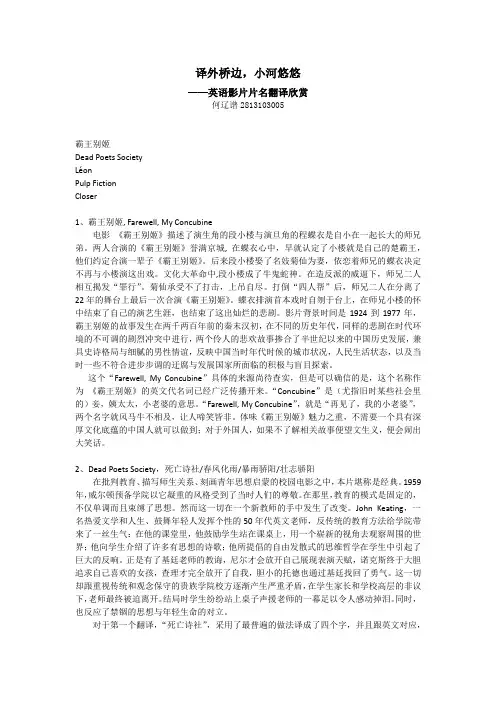
译外桥边,小河悠悠——英语影片片名翻译欣赏何辽谱2813103005霸王别姬Dead Poets SocietyLéonPulp FictionCloser1、霸王别姬, Farewell, My Concubine电影《霸王别姬》描述了演生角的段小楼与演旦角的程蝶衣是自小在一起长大的师兄弟。
两人合演的《霸王别姬》誉满京城,在蝶衣心中,早就认定了小楼就是自己的楚霸王,他们约定合演一辈子《霸王别姬》。
后来段小楼娶了名妓菊仙为妻,依恋着师兄的蝶衣决定不再与小楼演这出戏。
文化大革命中,段小楼成了牛鬼蛇神。
在造反派的威逼下,师兄二人相互揭发“罪行”。
菊仙承受不了打击,上吊自尽。
打倒“四人帮”后,师兄二人在分离了22年的舞台上最后一次合演《霸王别姬》。
蝶衣排演首本戏时自刎于台上,在师兄小楼的怀中结束了自己的演艺生涯,也结束了这出灿烂的悲剧。
影片背景时间是1924到1977年,霸王别姬的故事发生在两千两百年前的秦末汉初,在不同的历史年代,同样的悲剧在时代环境的不可调的剧烈冲突中进行,两个伶人的悲欢故事掺合了半世纪以来的中国历史发展,兼具史诗格局与细腻的男性情谊,反映中国当时年代时候的城市状况,人民生活状态,以及当时一些不符合进步步调的迂腐与发展国家所面临的积极与盲目探索。
这个“Farewell, My Concubine”具体的来源尚待查实,但是可以确信的是,这个名称作为《霸王别姬》的英文代名词已经广泛传播开来。
“Concubine”是(尤指旧时某些社会里的)妾,姨太太,小老婆的意思。
“Farewell, My Concubine”,就是“再见了,我的小老婆”,两个名字就风马牛不相及,让人啼笑皆非。
体味《霸王别姬》魅力之重,不需要一个具有深厚文化底蕴的中国人就可以做到;对于外国人,如果不了解相关故事便望文生义,便会闹出大笑话。
2、Dead Poets Society,死亡诗社/春风化雨/暴雨骄阳/壮志骄阳在批判教育、描写师生关系、刻画青年思想启蒙的校园电影之中,本片堪称是经典。
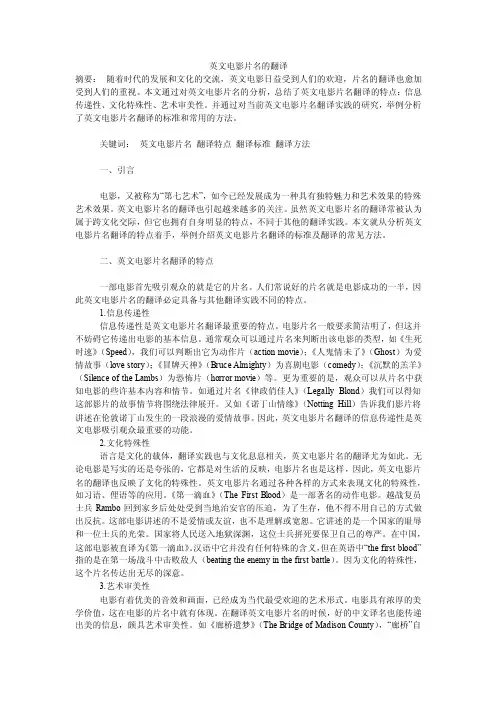
英文电影片名的翻译摘要:随着时代的发展和文化的交流,英文电影日益受到人们的欢迎,片名的翻译也愈加受到人们的重视。
本文通过对英文电影片名的分析,总结了英文电影片名翻译的特点:信息传递性、文化特殊性、艺术审美性。
并通过对当前英文电影片名翻译实践的研究,举例分析了英文电影片名翻译的标准和常用的方法。
关键词:英文电影片名翻译特点翻译标准翻译方法一、引言电影,又被称为“第七艺术”,如今已经发展成为一种具有独特魅力和艺术效果的特殊艺术效果。
英文电影片名的翻译也引起越来越多的关注。
虽然英文电影片名的翻译常被认为属于跨文化交际,但它也拥有自身明显的特点,不同于其他的翻译实践。
本文就从分析英文电影片名翻译的特点着手,举例介绍英文电影片名翻译的标准及翻译的常见方法。
二、英文电影片名翻译的特点一部电影首先吸引观众的就是它的片名。
人们常说好的片名就是电影成功的一半,因此英文电影片名的翻译必定具备与其他翻译实践不同的特点。
1.信息传递性信息传递性是英文电影片名翻译最重要的特点。
电影片名一般要求简洁明了,但这并不妨碍它传递出电影的基本信息。
通常观众可以通过片名来判断出该电影的类型,如《生死时速》(Speed),我们可以判断出它为动作片(action movie);《人鬼情未了》(Ghost)为爱情故事(love story);《冒牌天神》(Bruce Almighty)为喜剧电影(comedy);《沉默的羔羊》(Silence of the Lambs)为恐怖片(horror movie)等。
更为重要的是,观众可以从片名中获知电影的些许基本内容和情节。
如通过片名《律政俏佳人》(Legally Blond)我们可以得知这部影片的故事情节将围绕法律展开。
又如《诺丁山情缘》(Notting Hill)告诉我们影片将讲述在伦敦诺丁山发生的一段浪漫的爱情故事。
因此,英文电影片名翻译的信息传递性是英文电影吸引观众最重要的功能。
2.文化特殊性语言是文化的载体,翻译实践也与文化息息相关,英文电影片名的翻译尤为如此。
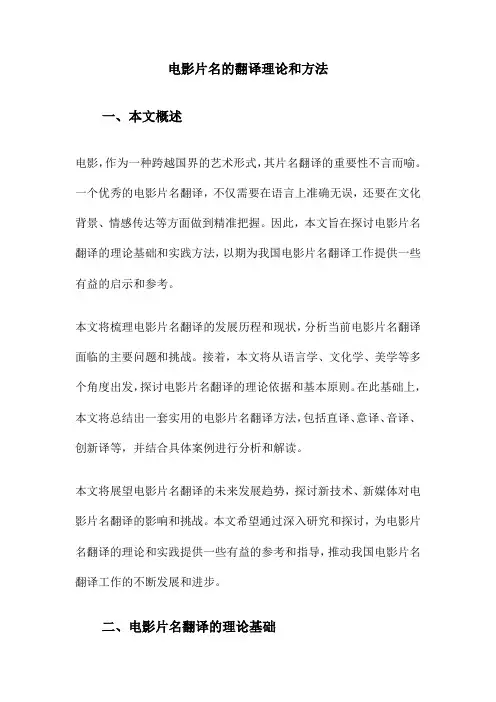
电影片名的翻译理论和方法一、本文概述电影,作为一种跨越国界的艺术形式,其片名翻译的重要性不言而喻。
一个优秀的电影片名翻译,不仅需要在语言上准确无误,还要在文化背景、情感传达等方面做到精准把握。
因此,本文旨在探讨电影片名翻译的理论基础和实践方法,以期为我国电影片名翻译工作提供一些有益的启示和参考。
本文将梳理电影片名翻译的发展历程和现状,分析当前电影片名翻译面临的主要问题和挑战。
接着,本文将从语言学、文化学、美学等多个角度出发,探讨电影片名翻译的理论依据和基本原则。
在此基础上,本文将总结出一套实用的电影片名翻译方法,包括直译、意译、音译、创新译等,并结合具体案例进行分析和解读。
本文将展望电影片名翻译的未来发展趋势,探讨新技术、新媒体对电影片名翻译的影响和挑战。
本文希望通过深入研究和探讨,为电影片名翻译的理论和实践提供一些有益的参考和指导,推动我国电影片名翻译工作的不断发展和进步。
二、电影片名翻译的理论基础电影片名的翻译是一项富有挑战性的任务,它需要在保持原片名的艺术性和文化特色的尽可能地吸引目标观众的注意力。
为了实现这一目标,翻译者需要遵循一系列的理论基础,包括语言学理论、翻译学理论、跨文化交际理论以及接受美学理论。
语言学理论为电影片名翻译提供了语言层面的指导。
翻译者需要了解源语言和目标语言的语言特点和语法结构,以便在翻译过程中保持语言的一致性和准确性。
语言学理论还强调了语言的社会性和文化性,提醒翻译者要注意语言背后的文化含义和社会背景。
翻译学理论为电影片名翻译提供了翻译策略和方法的指导。
翻译者需要了解直译、意译、音译等不同的翻译方法,并根据电影的类型、风格和受众群体选择合适的翻译策略。
同时,翻译学理论还强调了翻译的忠实性和创造性,要求翻译者在保持原片名意义的基础上,进行创造性的转化,使目标观众能够更好地理解和接受。
跨文化交际理论为电影片名翻译提供了文化层面的指导。
翻译者需要了解不同文化之间的差异和相似之处,以便在翻译过程中避免文化冲突和误解。
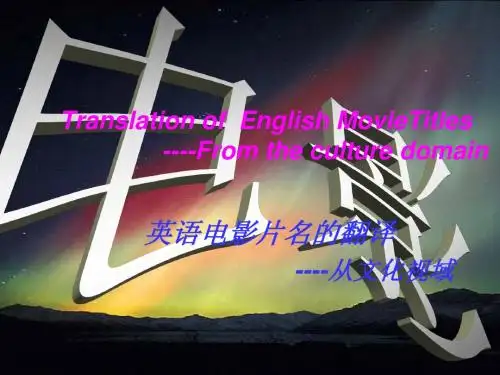
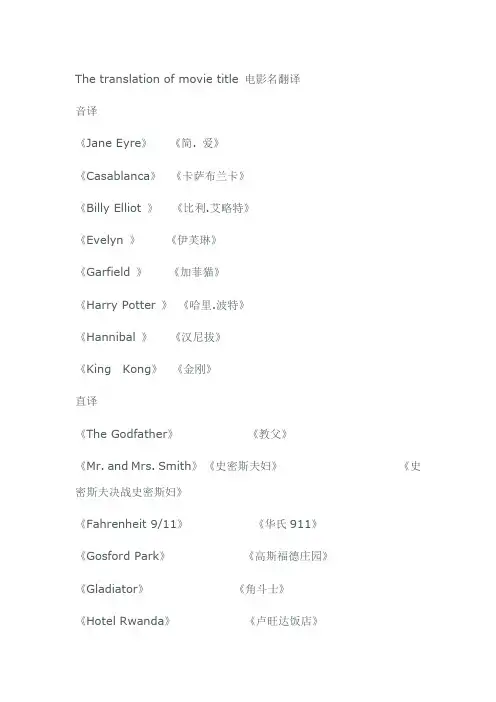
The translation of movie title 电影名翻译音译《Jane Eyre》《简. 爱》《Casablanca》《卡萨布兰卡》《Billy Elliot 》《比利.艾略特》《Evelyn 》《伊芙琳》《Garfield 》《加菲猫》《Harry Potter 》《哈里.波特》《Hannibal 》《汉尼拔》《King Kong》《金刚》直译《The Godfather》《教父》《Mr. and Mrs. Smith》《史密斯夫妇》《史密斯夫决战史密斯妇》《Fahrenheit 9/11》《华氏911》《Gosford Park》《高斯福德庄园》《Gladiator》《角斗士》《Hotel Rwanda》《卢旺达饭店》《Kill Bill》《杀死比尔》《Basic Instinct》《本能》意译《The Waterloo Bridge》《魂断蓝桥》《The Bridges of Madison Country》《廊桥遗梦》《Lolita》《一树梨花压海棠》《Leon the Professional》《这个杀手不太冷》《Lethal Weapon》《轰天炮》《Impossible Mission 》《碟中谍》《E.T》《外星人》《Bridget Jones》《BJ单身日记》《Bruce Almighty》《冒牌天神》《The Matrix》(1999) 《黑客帝国》《The Matrix Reloaded 》(2003) (重装上阵) 《The Matrix Revolutions 》(2003) (矩阵革命)《Going On 30》《女孩梦三十》《Holes》《别有洞天》《The Interpreter》《翻译风波》《Home Alone 》《小鬼当家》混译《Schindl er’s List》《辛德勒的名单》《Sissi》《西西公主》《Elizabeth》《伊丽莎白女王》《Forrest Gump》《阿甘正传》《Joe Dirt》《乔-德特历险记》《Kangaroo Jack》《抢钱袋鼠》《Lost in Translation》《迷失东京》《Shakespeare In Love 》《莎翁情史》中国电影的英文译名《Farewell My Concubine》《霸王别姬》《Be There or Be Square》《不见不散》《Seventeen Years》《回家过年》《Ashes of Time》《东邪西毒》《All Men Are Brothers: Blood of the Leopard》《水浒传》《Chinese Odyssey 1: Pandora‘s Box》中国的奥德赛1:潘多拉宝盒(《大话西游之月光宝盒》《Chinese Odyssey 2: Cinderella 》灰姑娘(《大话西游之仙履奇缘》《Funeral of the Famous Star》《大腕》明星的葬礼港台电影译名《Legally Blonde》台湾翻译:金法尤物香港翻译:律政可人儿《Moulin Rouge 》台湾翻译:红磨坊香港翻译:情陷红磨坊《The One》宇宙追缉令台湾翻译:救世主香港翻译:最后一强《Pay It Forward 》《浮世因缘》台湾翻译:让爱传出去香港翻译:拉阔爱的人《Amelie》艾梅丽台湾翻译:艾蜜莉的异想世界香港翻译:天使爱美丽《Rush Hour》台湾翻译:尖峰时刻香港翻译:火并时速《Chocolate》台湾翻译:浓情巧克力香港翻译:情迷朱古力《Tomb Raider》古墓丽影台湾翻译:古墓奇兵香港翻译:盗墓者罗拉《Cats &Dogs 》台湾翻译:猫狗大战香港翻译:猫狗斗一番《Dr. Dolittle》台湾翻译:怪医杜立德香港翻译:D老笃日记American Sweethearts》台湾翻译:美国甜心香港翻译:甜心人《Billy Elliot》芭蕾之梦台湾翻译:舞动人生香港翻译:跳出我天地On Translating English Film Titles from the CulturalPerspective IntroductionAs an audiovisual art, film is one of the most influential mass media, it follows and reflects people’s life and it is a product of particular culture. Over the past decades, with the increase in cultural exchanges, the western movies have gradually entered the Chinese market and held an important position in Chinese people’s recreational life.The film title, being short in form but rich in meaning, has its own cultural, linguistic, aesthetic features. A properly-translated English movie title should be concise, condensed and compact, which can grip the attention of the audience at their first sight and stimulate their association with the plot, reveal the theme or offer some clue. So they deserve careful investigation and consideration from the translator. However, as a branch of non-literary translation, it has not yet received due attention despite their importance.Therefore, in this thesis, I will introduce the general features and functions of English film titles, analyzing the translation techniques largely employed in film title translation. Furthermore, I will examine from the cultural perspective the different versions in Mainland, Hong Kong and Taiwan, and analyze the relevant strategies adopted and the effectiveness of these strategies. The social-cultural context of each region will be explored to find the factors resulting in this disunity in versions作为一种视听艺术,电影是最有影响力的大众媒体,它遵循并反映人民群众的生命,它也是一种特别的文化产品。
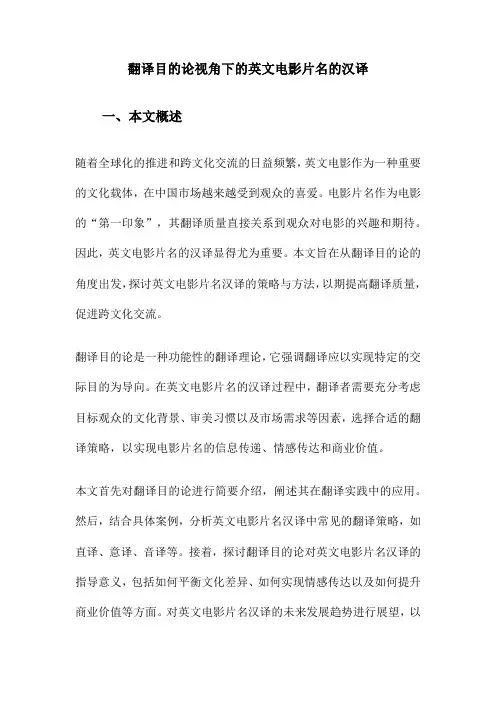
翻译目的论视角下的英文电影片名的汉译一、本文概述随着全球化的推进和跨文化交流的日益频繁,英文电影作为一种重要的文化载体,在中国市场越来越受到观众的喜爱。
电影片名作为电影的“第一印象”,其翻译质量直接关系到观众对电影的兴趣和期待。
因此,英文电影片名的汉译显得尤为重要。
本文旨在从翻译目的论的角度出发,探讨英文电影片名汉译的策略与方法,以期提高翻译质量,促进跨文化交流。
翻译目的论是一种功能性的翻译理论,它强调翻译应以实现特定的交际目的为导向。
在英文电影片名的汉译过程中,翻译者需要充分考虑目标观众的文化背景、审美习惯以及市场需求等因素,选择合适的翻译策略,以实现电影片名的信息传递、情感传达和商业价值。
本文首先对翻译目的论进行简要介绍,阐述其在翻译实践中的应用。
然后,结合具体案例,分析英文电影片名汉译中常见的翻译策略,如直译、意译、音译等。
接着,探讨翻译目的论对英文电影片名汉译的指导意义,包括如何平衡文化差异、如何实现情感传达以及如何提升商业价值等方面。
对英文电影片名汉译的未来发展趋势进行展望,以期为相关领域的翻译实践和研究提供参考。
二、翻译目的论在英文电影片名汉译中的应用翻译目的论为英文电影片名的汉译提供了全新的视角和理论支持。
在翻译过程中,翻译者不仅要考虑源语言和目标语言的文化差异,还需要充分考虑到电影片名的目的和功能,即吸引观众、传达电影主题等。
在英文电影片名的汉译中,翻译者通常会采用直译、意译、音译和创译等方法。
这些方法的选择和应用,往往取决于翻译者的翻译目的和对源语言和目标语言文化的理解。
例如,对于一些具有明确意象和象征意义的片名,翻译者可能会选择直译,以保持其原有的文化特色和艺术美感。
而对于一些难以直译或意译的片名,翻译者则可能会采用音译或创译的方法,以创造出新的、符合目标语言文化习惯的片名。
翻译目的论还强调翻译过程中的目标语言读者的接受度和反应。
因此,在英文电影片名的汉译中,翻译者还需要充分考虑到目标语言读者的审美习惯、文化背景和价值观等因素,以确保翻译后的片名能够引起目标语言读者的共鸣和兴趣。
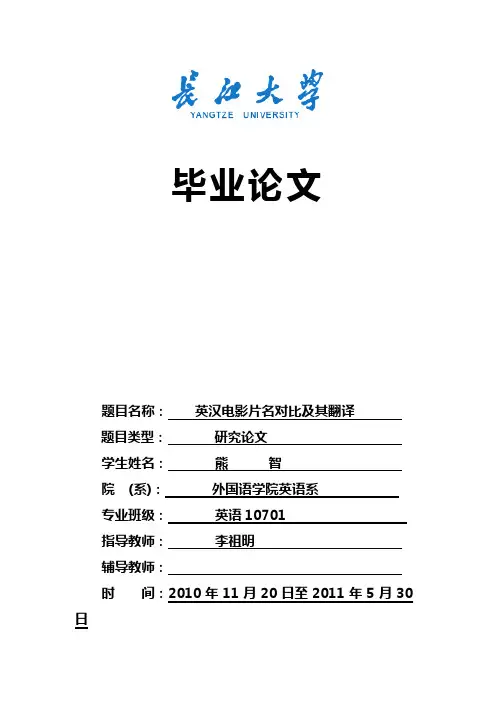
毕业论文题目名称:英汉电影片名对比及其翻译题目类型:研究论文学生姓名:熊智院 (系):外国语学院英语系专业班级:英语10701指导教师:李祖明辅导教师:时间:2010年11月20日至2011年5月30日英汉电影片名对比及其翻译熊智总计:毕业论文40页指导教师:李祖明评阅教师:完成日期:2011年5月30日On the Comparison between English and Chinese Film Titles and Their TranslationA ThesisPresented to the School of Foreign LanguagesY angtze UniversityBy Xiong ZhiIn Partial Fulfillment of the RequirementsFor the Degree ofBachelor of ArtsMay 2011Thesis Supervisor: Professor Li Zuming目录任务书 (I)文献综述............................................................I I I 指导老师审查意见 (Ⅸ)评阅老师评语 (Ⅹ)答辩会议记录及成绩评定 (Ⅺ)中文摘要 (Ⅻ)外文摘要 (IV)正文目录 (IV)正文 (1)参考文献 (28)致谢 (30)外文资料翻译(英文原文) (II)外文资料翻译(中文译文) (VII)长江大学毕业设计(论文)任务书学院(系)外国语学院专业英语班级英本10701学生姓名熊智指导教师/职称李祖明/副教授1.毕业设计(论文)题目:英汉电影片名对比及其翻译2.毕业设计(论文)起止时间2010年12月15日~2011年5月30日3.毕业设计(论文)所需资料及原始数据(指导教师选定部分)[1]王焰,郑贤贵.英文电影片名的翻译策略与翻译方法研究[J].西华大学学报(哲学社会科学版),2005(06).[2]龙千红.英语电影片名佳译赏析——兼谈电影翻译对译者的要求[J].西安外国语学院报, 2003(09).[3]徐建国.英汉翻译中的文化差异及其超越——以中英文电影片名翻译为例[J].黔西南民族师范高等专科学校学报,2008(09).[4]朱湘军,宋京松.从东西方不同的哲学思维看英汉电影片名[J].怀化师专学报,2001.[5]张茜.中英文电影片名的现状及特点[J].文艺理论,2009.[6]钱绍昌.影视翻译——翻译园地中愈来愈重要的领域[J].中国翻译,2000.[7]欧伟鹏.浅谈电影片名英汉翻译的原则及策略[J].漳州职业技术学院学报,2008.[8]毛发生.两岸三地外语影片片名的翻译比较[J].西安外国语学院学报,2002.[9]李楠.刘金铃文化视域下的中美电影片名翻译[J].电影文学,2010.[10]苗宁.中文电影片名英译探析[J].影视文学,2008.4.毕业设计(论文)应完成的主要内容从英汉电影片名的对比出发,分析英汉电影片名各自的特点;具体介绍英汉电影片名的翻译,英汉电影片名翻译的原则、翻译的方法、归化和异化、目前的现状、存在的问题、改进的方法,最后总结。
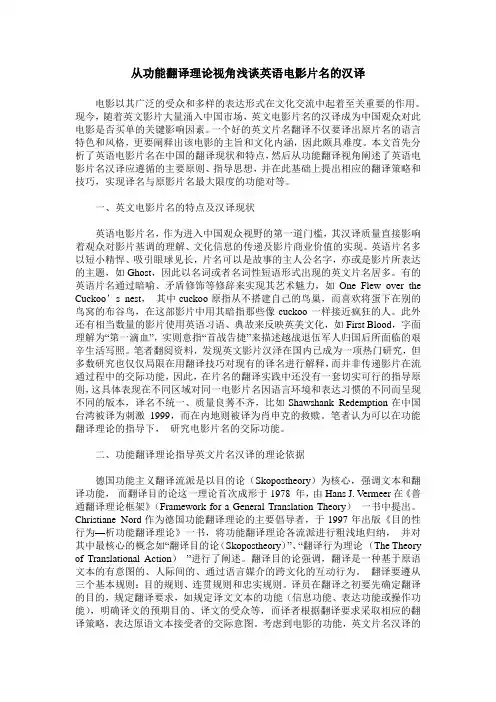
从功能翻译理论视角浅谈英语电影片名的汉译电影以其广泛的受众和多样的表达形式在文化交流中起着至关重要的作用。
现今,随着英文影片大量涌入中国市场,英文电影片名的汉译成为中国观众对此电影是否买单的关键影响因素。
一个好的英文片名翻译不仅要译出原片名的语言特色和风格,更要阐释出该电影的主旨和文化内涵,因此颇具难度。
本文首先分析了英语电影片名在中国的翻译现状和特点,然后从功能翻译视角阐述了英语电影片名汉译应遵循的主要原则、指导思想,并在此基础上提出相应的翻译策略和技巧,实现译名与原影片名最大限度的功能对等。
一、英文电影片名的特点及汉译现状英语电影片名,作为进入中国观众视野的第一道门槛,其汉译质量直接影响着观众对影片基调的理解、文化信息的传递及影片商业价值的实现。
英语片名多以短小精悍、吸引眼球见长,片名可以是故事的主人公名字,亦或是影片所表达的主题,如Ghost,因此以名词或者名词性短语形式出现的英文片名居多。
有的英语片名通过暗喻、矛盾修饰等修辞来实现其艺术魅力,如One Flew over the Cuckoo’s nest,其中cuckoo原指从不搭建自己的鸟巢,而喜欢将蛋下在别的鸟窝的布谷鸟,在这部影片中用其暗指那些像cuckoo一样接近疯狂的人。
此外还有相当数量的影片使用英语习语、典故来反映英美文化,如First Blood,字面理解为“第一滴血”,实则意指“首战告捷”来描述越战退伍军人归国后所面临的艰辛生活写照。
笔者翻阅资料,发现英文影片汉泽在国内已成为一项热门研究,但多数研究也仅仅局限在用翻译技巧对现有的译名进行解释,而并非传递影片在流通过程中的交际功能,因此,在片名的翻译实践中还没有一套切实可行的指导原则,这具体表现在不同区域对同一电影片名因语言环境和表达习惯的不同而呈现不同的版本,译名不统一、质量良莠不齐,比如Shawshank Redemption在中国台湾被译为刺激1999,而在内地则被译为肖申克的救赎。
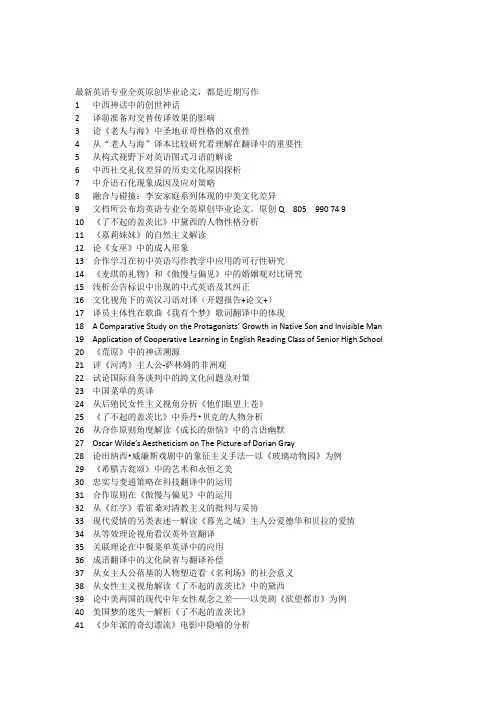
最新英语专业全英原创毕业论文,都是近期写作1 中西神话中的创世神话2 译前准备对交替传译效果的影响3 论《老人与海》中圣地亚哥性格的双重性4 从“老人与海”译本比较研究看理解在翻译中的重要性5 从构式视野下对英语图式习语的解读6 中西社交礼仪差异的历史文化原因探析7 中介语石化现象成因及应对策略8 融合与碰撞:李安家庭系列体现的中美文化差异9 文档所公布均英语专业全英原创毕业论文。
原创Q 805 990 74 910 《了不起的盖茨比》中黛西的人物性格分析11 《嘉莉妹妹》的自然主义解读12 论《女巫》中的成人形象13 合作学习在初中英语写作教学中应用的可行性研究14 《麦琪的礼物》和《傲慢与偏见》中的婚姻观对比研究15 浅析公告标识中出现的中式英语及其纠正16 文化视角下的英汉习语对译(开题报告+论文+)17 译员主体性在歌曲《我有个梦》歌词翻译中的体现18 A Comparative Study on the Pro tagonists’ Growth in Native Son and Invisible Man19 Application of Cooperative Learning in English Reading Class of Senior High School20 《荒原》中的神话溯源21 评《河湾》主人公-萨林姆的非洲观22 试论国际商务谈判中的跨文化问题及对策23 中国菜单的英译24 从后殖民女性主义视角分析《他们眼望上苍》25 《了不起的盖茨比》中乔丹•贝克的人物分析26 从合作原则角度解读《成长的烦恼》中的言语幽默27 Oscar Wilde’s Aestheticism on The Picture of Dorian Gray28 论田纳西•威廉斯戏剧中的象征主义手法—以《玻璃动物园》为例29 《希腊古瓮颂》中的艺术和永恒之美30 忠实与变通策略在科技翻译中的运用31 合作原则在《傲慢与偏见》中的运用32 从《红字》看霍桑对清教主义的批判与妥协33 现代爱情的另类表述—解读《暮光之城》主人公爱德华和贝拉的爱情34 从等效理论视角看汉英外宣翻译35 关联理论在中餐菜单英译中的应用36 成语翻译中的文化缺省与翻译补偿37 从女主人公蓓基的人物塑造看《名利场》的社会意义38 从女性主义视角解读《了不起的盖茨比》中的黛西39 论中美两国的现代中年女性观念之差——以美剧《欲望都市》为例40 美国梦的迷失—解析《了不起的盖茨比》41 《少年派的奇幻漂流》电影中隐喻的分析42 商标名的英译汉目的论研究——以洗护用品为例43 高中学生英语课堂口语交际活动的错误分析44 从《京华烟云》探析林语堂的女性观45 英语体育新闻标题的特点及翻译对策46 论《进入黑夜的漫长旅程》的悲剧成因47 对《名利场》中女主人公的性格特征分析48 试析《啊,拓荒者》中的生态伦理观49 设计中国际主义风格与民族主义风格的平衡50 从翻译角度浅析英语写作中的中式英语问题51 浅谈体态语及其在跨文化交际中的作用52 商务英语的语用特点及翻译53 男权制度下的悲剧——论《德伯家的苔丝》54 浅析《汤姆叔叔的小屋》中黑奴的命运55 Coincidences and Images in The Mayor of Casterbridge, Tess of the D’Urbervilles56 Politeness and Its Manifestation in Business Correspondence57 A Contrastive Analysis of Chinese and English Address Terms58 公示语翻译失当分析——以电影票等的顾客分析为例( )59 从原型批评理论角度分析威利•洛曼的悲剧60 虽不起眼,但不可或缺:从《洛丽塔》中的小人物看亨伯特悲剧的必然性61 商标翻译的本土化研究62 美国主流文化形成探析63 从目的论角度比较研究《彼得•潘》两个中文译本64 浅析英汉宗教死亡委婉语的异同65 Culture-oriented Strategies in Publicity Material Translation for Yangzhou City: a Perspective of Functionalism66 论中西方零售业企业文化的对比67 On the Pursuit of Ideal Home in Cold Mountain68 《围城》英译本衔接研究69 “邪恶的心灵”——剖析希斯克厉夫复仇的心理动机70 《野性的呼唤》中的人性和野性71 An Analysis of Symbolic Metaphor in To the Lighthouse72 英汉礼貌用语及交际策略的对比分析73 从传播美学分析国内畅销知名化妆品广告中的译文74 An Imitation of the Primitive Society: Evil of Human Nature in Lord of the Flies75 从《麦琪的礼物》看欧亨利的写作手法76 对美国总统就职演说的文体分析77 论国际商务非礼貌言语行为78 浅析《最蓝的眼睛》中的叙事艺术79 [毕业论文](经贸英语系毕业论文)以海尔集团为例浅析售后服务在企业营销中的作用80 从痛苦中顿悟—《麦田里的守望者》成长主题解读81 浅析跨文化交际中的中英社交称谓82 丘吉尔《就希特勒入侵苏联发表的讲话》的修辞赏析83 《月下独酌》两种英文译本之对比研究84 从合作原则谈影视翻译策略——以《功夫熊猫》为例85 伦敦英语在英语标准化过程中的作用86 从女性主义视角解读《飘》中斯嘉丽•奥哈拉的性格特征87 浅析文化差异对中美商务谈判的影响88 网络英语交际对会话合作原则的影响89 Problems Occured in the Process of the Chinese Learning English and Its Possible Solution90 美国宗教文化及价值观在其外交政策中的体现91 新课标下初中英语教师角色转变的研究92 从《河东狮吼》与《套礼服》的对比中分析中美婚礼的差异93 论英语小说中俚语的汉译94 The Influence of Cross-Cultural Communication on Translation95 安吉尔的精神悲剧—分析哈代笔下人物的心理发展过程96 女性主义视角下《白象似的群山》与《莳萝泡菜》中男性形象的对比研究97 浅析爱德华·摩根·福斯特《霍华德庄园》中的语言特色98 从广交会现场洽谈角度论英语委婉语在国际商务谈判中的功能与应用99 论《简爱》中的经济意识100 浅谈英汉人体部位的隐喻101 A comparison of values of money between Scarlett and Gatsby102 从女权主义视角分析《红字》中海斯特白兰的形象103 《人鼠之间》中两主人公乔治和雷尼的对比分析104 The Growth Topic in The Catcher in the Rye105 从关联理论看家庭会话冲突106 中美企业并购中的文化整合分析107 春节与圣诞节的对比研究108 从好莱坞电影中的中国元素看美国对中国意识观念的转变109 A Tentative Study of Affective Factors in Second Language Acquisition110 从爱伦·坡《黑猫》探讨人性的善良与邪恶111 从弗洛伊德的精神分析理论浅析《道林格雷的画像》中的主要人物112 从语义翻译与交际翻译看《红楼梦》中诗词的汉译英113 Passion & Religion — A Comparison between The Scarlet Letter and The Thorn Birds114 汉语句型习惯对英文写作的负迁移作用115 论《天路历程》的批判精神116 动物词在中英文化中的喻义及其翻译117 A Linguistic Analysis o f Barack Obama’s Inauguration Speech118 论密西西比河对马克吐温和《哈克贝利费恩历险记》的影响119 论“看,易,写”方法在旅游翻译中的应用120 从小说人物分析简•奥斯汀的情感智慧121 论自然主义在《野性的呼唤》中的体现122 等效理论框架下的中国菜肴英译研究123 弗吉尼亚•伍尔夫《海浪》的叙事技巧分析124 从跨文化传播角度论中国饮食文化资料的英译125 公示语的功能、语言特点及翻译126 《道连·格雷的画像》中意识与潜意识的对抗与结合127 An Analysis of Feminism in The Scarlet Letter128 从古至今的吸血鬼文化129 中世纪的典雅爱情:本质、渊源和影响130 从弗吉尼亚伍尔夫到多丽丝莱辛:论女性主义的发展——对比两位作家笔下塑造的女性形象131 商标翻译及商标翻译中的文化禁忌132 An Analysis of David’ s Dual Personality in David Copperfield133 中美商务英语信函的对比研究134 The Use of Symbols in A Farewell to Arms135 The Exploration of Black Female Characters in Toni Morrison’s Novels136 英语中源于希腊罗马神话主要神祇姓名词汇的认知探索137 从文化差异角度研究英文新闻标题翻译的策略138 论爱伦坡小说中的哥特式风格139 On the Female Initiation Theme in Little Women140 浅谈中美文化差异对商务谈判的影响141 论《儿子与情人》中保罗的爱情悲剧142 《呼唤》中倒装句汉译策略研究143 浅析广告发展现状及其未来发展趋势144 The Application of Corpus in Teaching English Writing145 A Comparison of the English Color Terms146 《荆棘鸟》中女性主义及女性意识觉醒的解读147 目的论视角下新闻标题汉译英研究148 英语X-ful词的形态与认知构建149 《到灯塔去》中的两性主义—抵达人类和谐的完美道路150 《三国演义》中带数字的词语翻译研究151 中英植物习语中的文化差异分析152 从女性主义视角看《蝴蝶梦》153 如果不复仇——论呼啸山庄中的爱与恨154 以学生为主体的教学在初中英语写作教学中的应用155 高中英语互动式课堂教学模式研究156 分析露丝的觉醒《接骨师之女》157 英语X-ful词的形态与认知构建158 从关联理论角度看英语广告语的修辞159 On Misreading in Reading Comprehension from the Perspective of Discourse Analysis160 从跨文化角度论谚语中的比喻与翻译161 论约翰•多恩诗歌中的张力162 中西方饮食文化比较研究163 英语委婉语的语用分析164 论反语的语用功能165 中英花卉隐喻下的情感叙事对比研究166 网上英语聊天的会话结构特征167 叶芝:无望的爱情,多变的风格168 英汉思维方式差异对英译汉结构处理的影响169 从成长小说角度解读《马丁•伊登》170 Pragmatic Failures in Translation of C-E Advertisements171 从跨文化交际层面谈口译译者能力的提高172 交际法在中学英语词汇教学的应用173 在幻想中回归童年──评析《爱丽丝漫游奇境记》174 《贵妇的画像》的过渡性特征的分析研究175 探究哈利波特的英雄成长之路176 The differences on advertising translations under the Chinese and Western cultures 177 不做房间里的天使——解读《爱玛》中的女性主体意识178 影响中学生英语学习的心理因素分析179 《高级英语》中某些修辞手法赏析180 从十字军东征看中世纪宗教冲突181 从校园流行语看中美学生思维方式的差异182 从文化差异角度看英汉习语的翻译183 从中西婚礼文化看中西方文化差异184 《动物庄园》中的黑色幽默分析185186 《野性的呼唤》中的自然主义187 试析《假如明天来临》的叙事艺术188 从《海狼》看杰克•伦敦的女性观189 The Loneliness in Far From the Madding Crowd190 论《外婆的家什》中的象征意义191 从文化差异角度谈国际商务谈判中的语言技巧192 A Study of Hawthorne’s Criticism on Puritanism in The Scarlet Letter193 王尔德唯美主义对现代消费文化的启示--以《道林格雷的画像》为例194 Scarlett O'Hara and Feminism195 英语介词的翻译196 合作原则在动画中的应用197 海明威“冰山原理”在《永别了,武器》中的应用及对写作的指导意义198 中医在英语世界的翻译与传播:过去与现在199 英文电影字幕翻译的原则和技巧。
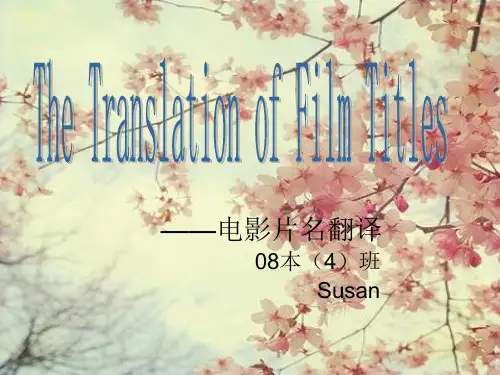
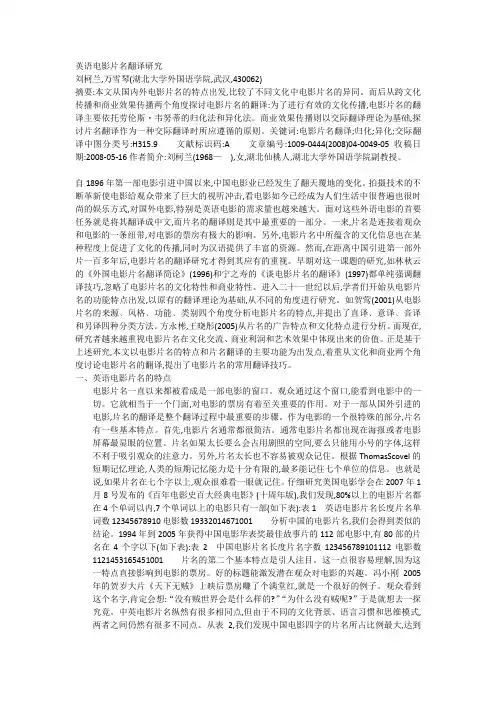
英语电影片名翻译研究刘柯兰,万雪琴(湖北大学外国语学院,武汉,430062)摘要:本文从国内外电影片名的特点出发,比较了不同文化中电影片名的异同。
而后从跨文化传播和商业效果传播两个角度探讨电影片名的翻译:为了进行有效的文化传播,电影片名的翻译主要依托劳伦斯・韦努蒂的归化法和异化法。
商业效果传播则以交际翻译理论为基础,探讨片名翻译作为一种交际翻译时所应遵循的原则。
关键词:电影片名翻译;归化;异化;交际翻译中图分类号:H315.9文献标识码:A文章编号:1009-0444(2008)04-0049-05收稿日期:2008-05-16作者简介:刘柯兰(1968—),女,湖北仙桃人,湖北大学外国语学院副教授。
自1896年第一部电影引进中国以来,中国电影业已经发生了翻天覆地的变化。
拍摄技术的不断革新使电影给观众带来了巨大的视听冲击,看电影如今已经成为人们生活中很普遍也很时尚的娱乐方式,对国外电影,特别是英语电影的需求量也越来越大。
面对这些外语电影的首要任务就是将其翻译成中文,而片名的翻译则是其中最重要的一部分。
一来,片名是连接着观众和电影的一条纽带,对电影的票房有极大的影响。
另外,电影片名中所蕴含的文化信息也在某种程度上促进了文化的传播,同时为汉语提供了丰富的资源。
然而,在距离中国引进第一部外片一百多年后,电影片名的翻译研究才得到其应有的重视。
早期对这一课题的研究,如林秋云的《外国电影片名翻译简论》(1996)和宁之寿的《谈电影片名的翻译》(1997)都单纯强调翻译技巧,忽略了电影片名的文化特性和商业特性。
进入二十一世纪以后,学者们开始从电影片名的功能特点出发,以原有的翻译理论为基础,从不同的角度进行研究。
如贺莺(2001)从电影片名的来源﹑风格﹑功能﹑类别四个角度分析电影片名的特点,并提出了直译﹑意译﹑音译和另译四种分类方法。
方永彬,王晓彤(2005)从片名的广告特点和文化特点进行分析。
而现在,研究者越来越重视电影片名在文化交流、商业利润和艺术效果中体现出来的价值。
从跨文化角度看英文电影片名的翻译【摘要】好电影离不开好片名。
作为叩响观众心灵之门的声音,电影片名直接反映了其美学欣赏和商业宣传的双重价值。
不仅简洁明了地介绍故事情节,引起观众兴趣,还为中西之间的跨文化交流提供了有利媒介。
随着国际文化交流的日益发展,电影片名在跨文化交际中发挥着越来越重的作用。
因此,本着文化传播与交流的目标,译者应忠于原意,发挥文化因素在翻译过程中的巨大作用。
【关键词】英语电影片名翻译;文化因素;翻译方法本文从跨文化传播的角度出发,分析欧美电影片名的中译现状以及在文化信息传递方面存在的不足,在分析跨文化传播视角下中国电影片名翻译的方法下,集中探讨文化因素发挥的作用。
文化是一个国家最重要的软实力,它作为一种精神力量,能够在人们认识世界、改造世界的过程中转化为物质力量,对社会发展产生深刻的影响。
这种影响,不仅表现在个人的成长历程中,而且表现在民族和国家的历史中。
随着国际化进程的不断加快,各国的政治、经济和文化也在日益加深。
作为民族文化产物的影视作品不断地走出国门,走向世界。
2015年,中国电影在海外的票房再创新高。
因此,在国外大片纷至沓来,国产影片走向国际的今天,中国也越来越关注电影翻译业的发展。
外国大片的翻译质量也受到了广泛的关注。
在中国上映的国外大片的翻译质量的高低不仅影响着原著的语言艺术,正确地传达影片所希望表达的信息外,还关系到它的票房和人气。
然而想要译好片名绝非易事,它不仅需要我们深刻了解影片的主题,还要求我们熟知影片所在地的文化含蕴,因此,从跨文化的视角去挖掘影片的内容与思想,从而才能正确地形象地翻译片名,这对于电影业的发展有着重要作用。
一、影响电影片名翻译的几个主要因素首先就是文化差异。
电影名称或多或少地反映其所属文化的特征。
世界各个民族的文化各具其特色,同一个事物在不同的民族代表不同的含义。
在中国,我们一直宣称我们是炎黄子孙是龙的传人,我们将龙信奉为圣物。
在古代中国帝王也以真龙天子自居。
论电影片名翻译的英汉对比电影片名的翻译是影响观众对电影的第一印象的重要因素。
随着全球化的发展,电影行业也变得越发国际化,因此电影片名的翻译也变得愈发重要。
在电影片名的翻译过程中,常常会出现英汉对比的情况,因为两种语言和文化之间存在着巨大的差异。
本文将从英汉两种语言的文化差异、翻译策略、以及具体案例出发,探讨电影片名翻译的英汉对比。
一、英汉文化差异对电影片名翻译的影响英汉两种语言和文化有着不同的历史、宗教、价值观念等,因此在翻译电影片名时,往往需要考虑文化差异对翻译的影响。
英汉两种语言的语法结构和表达方式不同,因此在翻译电影片名时会面临着语言结构和表达方式的差异。
英语中的电影片名通常采用简洁、有力的词语,而汉语中的电影片名往往更加注重情感表达。
因此在翻译时需要根据两种语言的特点进行调整,保持原片名的核心意思并使其在另一种语言中表达出来。
英汉两种文化在观念、价值观念上存在着巨大的差异,这也会对电影片名的翻译产生影响。
在英语文化中,对于恐怖、惊悚片名的接受度较高,而在中国文化中则更加注重和谐、温馨的题材。
因此在翻译电影片名时需要考虑观念和价值观的差异,调整片名以适应不同的文化环境。
二、电影片名翻译的策略在英汉两种语言的文化差异影响下,电影片名的翻译需要采取相应的策略来保持原片名的核心意思并使其在另一种语言中表达出来。
要注重原汁原味。
无论是中文片名翻译成英语,还是英语片名翻译成中文,都需要尽量保持原片名的特点和核心意义。
电影《终结者》(The Terminator)的中文翻译就保留了原片名的恐怖、史诗般的特点,使观众能够在片名中感受到电影所要传达的氛围和情感。
要顾及文化差异。
在翻译电影片名时需要考虑不同文化背景的受众。
电影《美丽心灵》(A Beautiful Mind)在翻译成中文时,将其片名调整为了更符合中国观众审美观念的《美丽心灵的疯狂》。
这样能更好地吸引中国观众的注意力,增加电影的票房收入。
要注重宣传效果。
电影片名翻译与语境适应论摘要:随着文化交流的扩大,越来越多的国外影片引进中国,受到观众的喜爱,越来越多的中国电影受到外国观众的关注。
电影标题作为电影语言的一部分,是电影第一面对受众的部分,其翻译自然是电影推广宣传的关键一环。
众所周知,电影标题也是社会语言的一部分,当然会涉及到社会文化形式的各个方面,包括政治,经济,历史,宗教等。
如何逾越不同社会文化背景所造成的理解鸿沟,是电影片名翻译首先要解决的问题。
语境适应论作为国内语用学范畴探讨的新理论,对如何逾越不同社会文化背景所造成的理解鸿沟有较强的指导性。
本文首先从商业、文化、艺术的视角指出了片名的重要性,接着分析了电影片名翻译主要影响因素——社会文化背景差异,然后详细分析了解决这一因素的语境适应论,并根据这一理论探讨指导中外电影片名互译的实用策略,同时指出语境适应理论对片名翻译有制约和延伸的作用。
关键词:电影片名;翻译; 文化差异; 语境适应论; 翻译策略ABSTRACT:With the development of culture exchange in the world, more and more English films have been introduced into our country, which have gained preference of the Chinese people. At the same time, Chinese films are favored by foreign audience. Film title is an important part of film language, and the first part to be directly confronted with the audiences, whose translation plays a critical role in promotion of the film production in international film market. As we all know, film title is also a portion of the social language, so it surely relate to aspects of the social culture, such as politics, economics, history, religion, etc.. Therefore, how to bridge the comprehension gap of the audiences from different cultural background is crucial to film title translation. Contextual Adaptation Theory, a hot topics in pragmatics nowadays, mainly talks about the key to bridge the gap of different contextual backgrounds, so this paper will apply contextual adaptation to the film title translation. Firstly, the importance of the film title translation is analyzed from the perspective of commerce, culture and art; then the paper discusses the main factors of film title translation, that is the difference of the cultural backgrounds; in the following chapter, Contextual Adaptation Theory is introduced in details, for the purpose of exploring the proper strategies of film title translation.Key words: film title; translation; cultural difference; contextual adaptation; translation strategy1 IntroductionAs we all known, film is an audio-visual art. This glamorous act is a magnificent gem in human history, which creates romantic stories and leads human into a marvelous land we have never come before. Looking back to the development history of film, we cannot deny that film reflects the society reality and the time spirit. As the cultural exchange between China and overseas become booming, film plays an important role as culture envoy. Film was entrusted with the mission to let more people from different cultural backgrounds to enjoy the entertainment and share advanced technology together. This is an unavoidable trend in the world now.As the most popular form of mass communication, film has accompanied human for almost one century. In the long history, film industry experiences six serious changes. From the era of film’s father Liaster brother taking black a nd white documentary into people’s life to the era of talkie, ever-big change of film industry has remarkable significance in human history. Countless famous film stars show their charming glamour on the screen and many excellent films are popular with audience in the whole world. Entering into 21 century, the film industry continues to develop rapidly, which is entrusted with the mission to let more people with different cultural background understand foreign culture. As the development of society, the trend of film importing and exporting is unavoidable due to the globalism.Since the policy of reform and opening carried out in China at the end of 1970s, an increasing amount of English films have entered Chinese market and the Chinese film industry has developed in the meantime. Both sides need to share the market and spread culture of each other. Therefore, it is curial to be accepted by the audience from other cultural background. Undoubtedly, film title translation is an important segment concerted, which is far from being explored. Film title musters the essence of the film wholly, and in some sense, a successful film title should be the one that can attract people to the cinema. A good translator should translate the film title in the base of the contextual adaptation, which reflects the culture surroundings of audience such as society current situation, religion and history. Those objective factors are in direct contact with acceptance and comprehension of audience. Actually, it is high time that film title translation should pay more attention to the contextual adaptation field. This paper makes a tentative study of Chinese and English film title translation with an attempt to formulate some practical theories and methods to explore film title translation.The film title musters the essence of the film wholly, and in some sense, a successful film title should be the one that can attract people to the cinema and that should become a great box-office hit.The intense rivalry of big film companies impels all film investors to pay careful attention to the international market. However, film title translation is a process to master the psychology and acceptance of foreign audiences. Namely, this process is a cruel segment to enter international market. The aim of translating film title is to inherit, that is to say, the translator should apply audience-oriented translation skills on the base of referring to film content in order to enter into the market successfully .The aim of film title translation lay the position of disseminating film . Translation is not just the process of language transferring, but the society phenomenon of culture exchange . [1]The great mission of film title translation is to incarnate the culture value and develop the understanding between different countries.Being a special and significant part of translation, film title translation has been piloted from many aspects, such as the angle of reception aesthetics, the perspective of skopostheorie and cultural perspective. A great portion of scholars keep their eyes on reception aesthetics which has often been taken as the theoretical background to analyze film title translation. Based on those theories, typical models are established aiming at providing the theoretical framework to guide film title translation. Those fruitful research contribute a lot to the work. However, till now not a single theory or theoretical frame has been set up to guide the film title translation, which is far from being explored in the past years.Contextual adaptation, a newly developed field in China, is adopted as the theoretical background of this paper and an audience-oriented English and Chinese film title translation approach is highly advocated. The reception process is a kind of Contextual adaptation, and the contextual adaptation significance of a literary work cannot be fully realized without the reader’s reception. Contextual adaptation provides us with a new perspective of the relationship between film and audience. Exploring the sources, types and styles of film title, this paper claims that translating film title is on the base of four-foundation rule: information value principle, culture value principle, aesthetic appreciation principle and business value principle. Accordingly, this paper put forward three basic translating methods with the guidance of contextual adaptation, which are literal translation, transliterate and adaptation. Then the paper will raise those translating approaches with rich examples to elaborate the importance and the way of applying contextual adaptation.Contextual adaptation serves as the theoretical base of this paper due to its apparent applicability of this newly developed field, which is testified as guiding principles. Convincing examples and proper methods have been given. Chapter One gives the importance introduction of film title translation, from the angle of social development and the angle of the aim of title translation. Chapter Two sates the definition, content and importance of contextual adaptation. Chapter Three studies the application of the contextual adaptation in film title translation, which includesfour-foundation rule and three basic translating methods with typical examples of film title translation.2 Main Factors In The Translation Of Film TitleThe translator should bear in mind that there are some main factors in the translation of film title. Aesthetic Principle, Ideology, Theme and Style of film are the main points that need careful consideration in the process of film title translation. Then, in this chapter, the key factors of film title translation will be analyzed according to rich examples.2.1 Aesthetic Principle And The Translation Of Film TitleChinese aesthetics emphasizes the balance very much, particularly in using the organizational structure of the language like a parallel symmetry. Therefore, Four- character phraseology is commonly used in Chinese film titles and the translated titles of foreign, such translated titles as 卢浮魅影, 生死时速, 完美风暴, 一往无前, 永不妥协, 天使之城, 择日而亡, 霹雳娇娃, 狼犬丹尼, 冰河世纪, etc.Westerners' aesthetic concepts is putting more emphasis on analysis and paying more attention to local and individual and advocating conciseness which is reflect on the film titles directly. Substantial factors affecting the development of the film plot (such as people, objects, things, location, etc.) or a single term are used as a film title universally, like the net, Saw, the piano, Congo, ghost, the car, cold mountain, King Kong, etc. So now many Chinese films, according to the appreciating custom and psychology, adopt the translated titles as brief as western films’, such as 决战紫禁之颠into the Dual; Jet lee’s latest film 霍元甲with the name Fearless; Chen Kaige’ s blockbuster 无极with its translated title the Promise; 看上去很美with the Little Red Flower, etc.2.2 Ideology And The Translation Of Film TitleThe concept of ideology has been broadening and its introduction to Translation Studies hasenabled researchers to probe into some translational phenomena, which might have been neglected otherwise. The ideological manipulation in translation could refer to "any interference with the text is it cultural, religious, political or otherwise, imposing modifications that are not textual constraints, for the purpose of indoctrination".[2]As growing and living in the different social system, the ideology of Chinese people and westerners are quite different even different between Hong Kong, Taiwan and china main land. the title of Chinese film 红色恋人audience know clearly it is about the love of the Communist in hard y ears. But in westerners’ mind, on one hand, they may not understand red lover indicate a couple of Communist lover, on the other hand, even if they know the t indicative meaning of the red in china, they do not identify with Communist at all. So it is a good choice to adopt creative translation with the film English title a time to remember.2.3 Theme And Style Of The FilmUsually the theme and style of the film is related to the film titles cheek by jowl. Naturally it is closely related to the translation of the film titles as well. A good translated title should reflect the main idea of the film proper, well and truly, which embody the theme and give prominence to the style of the film.To classify the 63 films according to its theme as follows:type Film Translated title Ethical Films American beauty美国美人Rain man雨人Monster 女魔头Forrest Gump 阿甘正传活着To liveCampus Life Film Coach Carter 铁血教练Mr. Holland's Opus 春风化雨American Pie 美国派10 Things I Hate About You对面恶女看过来War Films Apocalypse Now现代启示录Enemy at the Gates兵临城下All Quiet on the Western Front 西线无战事Hotel Rwanda 卢旺达饭店Saving Private Ryan 拯救大兵瑞恩Legend-Based Films Cleopatra埃及艳后Alexander 亚历山大大帝Troy 特洛伊King Arthur 亚瑟王The Aviator 飞行者Western film Dances with Wolves与狼共舞Unforgiven 不可饶恕To Kill a Mockingbird 杀死一只知更鸟Once upon a time in American义薄云天 Romance Notting Hill诺丁山开往春天的地铁Spring subwayAre We There Yet? 小鬼上路The Break Up 同床异梦Just My Luck倒霉爱神情迷大话王Everyday is valentines大城小事Leaving Me, Loving You Political Films Schindler's List 辛德勒的名单JFK刺杀肯尼迪Good night, good luck晚安,好运生死抉择Fatal decision Cartoon films Monsters, Inc. 怪物公司Robots机器人总动员Chicken run小鸡快跑Peter Pan 小飞侠 Sci-Fi Films Jurassic Park侏罗纪公园Artificial intelligent人工智能the Island 逃出克隆岛serenity 冲出宁静号Stealth 绝密飞行Thriller film The Others 小岛惊魂Silent Hill 寂静岭Halloween 月光光心慌慌Final Destination死神来了The Silence of the Lambs沉默的羔羊Musical film The Red Shoes红菱艳Chicago芝加哥Moulin Rouge梦断花都如果·爱Perhaps loveMarilyn Hotchkiss' Ballroom Dancing舞动心方向and Charm SchoolAction film Rush hour 尖峰时刻Cliffhanger绝岭雄风霍元甲fearlessDust to Glory 车舞狂沙喋血双雄The Killer纵横四海Once a ThiefDocumentary film Rize 瑞兹The Year of the Yao 挑战者姚明Fahrenheit 9/11华氏911Deep Sea 3D 深海大进击/深深的海We can see the film titles of different types above with different characteristics, Documentary film is the track record of true life and affairs in the world, so its translated title need brief and direct without any exaggeration or more special translating techniques. Ethical films usually have profound social meanings and ethical thinking, which have serious and elevated topics in truly sense. So the translated titles of ethical film do not need to be added some elements in translating, as the primary film name has been the best summary of the film. As to the legend-based films, war films and political film, they are all adapted from the true history in a largely scale, therefore we advocated the literal translation and we need the true and impersonal film title no matter after translation or not.Finally, title translation of the other kinds of film has a vast room to bring techniques and imaginations into play. Thriller’titles are to create thriller atmosphere so that abundant Chinese character and thriller cultural element could be used in translation. Romance’s translated titles should be warm, cozy, romantic and especially charming to female audiences and amatory audiences. Sci-Fi films titles should have fantastic and illusory color with some pressure, giving the imaginative room for audience. Cartoon film’ tit les should be cute, dramatic, simple-word and new-minded so as to attract both children and grown-up.3 Contextual AdaptationAs discussed above, whether the film title can be appreciated by target audience involves many aspects of human life, such as, politics, economy, history, all of which are included in macroscopic context. So to attract the target audience is to adapt their context. In this chapter, the author introduces the definition and content of contextual adaptation and makes a study of film title translation on this base due to its apparent applicability of this newly developed discipline. According to the contextual adaptation, a new visual angle to analyze target title can be raised.3.1 The Definition &Content Of Contextual AdaptationThe contextual adaptation is in the range of context, which notion is essential to the pragmatic study of language. [3]The context is divided into two portions, which are macroscopic context and microcosmic context.The macroscopic context means social cultural appearance, which involves every aspect of human life. [4]In contrast, the range of microcosmic context is narrow. We consider it as the concrete environment shared by the speaker and hearer. Accurately, the contextual adaptation is in the range of macroscopic context. There is a long history to explore contextual adaptation abroad, which is composed of microcosmic contextual adaptation and macroscopic contextual adaptation. The macroscopic contextual adaptation means the process of language adaptation to specific surrounding, which is analyzed in the aspect of the society and culture. [4]Social surroundings restricts using language, which are the foundation of language development and the most complicated factors in context. The social surroundings include politics, economy, religion, history, etc. Different nations have their own culture due to the specific social surroundings, which differ from that of other nations. Because of the culture relative independence, there is an understanding gap between native and foreign culture. To build a bridge over the gap is an arduous mission for translator. The microcosmic contextual adaptation refers to the use of sentence as what people actually utter in the course of communication. Actually, the macroscopic contextual adaptation is adopted as the theoretical background of this paper.3.2 Importance Of Contextual Adaptation On TranslationTraditionally, people consider translation as ―faithfulness‖. Translators have laid great emphasis on both source text and target text, on faithfully reproducing the original first in terms of meaning and second in terms of style. [5]Nevertheless, Professor Wu Jun explored the study of medium and considered the translation as ―the essence of translation is the transmit of information,that is communication‖ [6] It calls our attention to the transference of the efforts from the text to the reception of the potential reader. As a new voice out of context, contextual adaptation ushers in fresh air to local translation studies. Translator can become the bridge between different languages under the prerequisite of contextual adaptation. Namely, contextual adaptation is the foundation of culture exchange and understanding.3.3 Importance Of Contextual Adaptation On Film Title TranslationAs a popular art, film is tinged with a film of commercialization. When the film enters into target market, the first impression for audience is film title. Understanding film content is very important, but we should take contextual adaptation on the top of the list. Contextual adaptation provides us with a new perspective of the relationship between film and audience. Different nations have different traditional cultures and value preferences, letting along the distinction of western and eastern culture. Through comprehending contextual adaptation to find the appropriate approach, the deviation of understanding will be avoided. There are plenty of wonderful target names in film domain. Those successful cases state the importance of combination of film content and contextual adaptation during translation.4 The Application Of Contextual Adaptation In Film Title TranslationAs stated previously, to gain a toehold in the international market, the overseas and domestic film companies are bumping up efforts to put forward their film to target audiences. Obviously, contextual adaptation is curial in the film title translation. It is the contextual adaptation that endows the title with uniqueness that pleases the senses and provided audience enjoyment. In this chapter, the strategies of film title translation will be analyzed according to the fundamentals of contextual adaptation.4.1 Realization Of Four Basic PrinciplesIn the process of film title translation, translator should persist in four basic Principles for the propose to make the effect of culture exchange. The four basic points are the informative value, the cultural value, the aesthetic value and the commercial value. Those points are the concrete centerpieces in exploring contextual adaptation from theory to practice. According to the standard of contextual adaptation, there are three audience-oriented title translation skills:literal translation , transliterate and adaptation.4.2 The Feasibility Of Contextual Adaptation In Film Title TranslationAs the newly developed filed, contextual adaptation can be the guidance of the audience-oriented translation skills in film title translation. Translator can regard the contextual adaptation as the criterion to judge the target title whether it is successful or not. The restriction and extension of film title translation in perspective of contextual adaptation will be raised with typical examples as follows.4.2.1Restriction Of Film Title Translation In Perspective Of Contextual AdaptationFilm title translation is restricted seriously by contextual adaptation due to the distinctive cultural background. Those objective factors take the surroundings of audiences into translator’s consideration in order to inherit essence of the original title.As a matter of fact, ma ny English films and Chinese films are full of legendary contents that’ll thrill audiences world wide, but their target titles are terrible. Take the famous Chinese film 《霸王别姬》for example, which was premiered at the Cannes festival.The film tells the vagrant life of artist of Beijing opera under the background of Cultural Revolution. Beijing opera 《霸王别姬》is the core point of whole film which is full of contradictions secrets, love and Chinese sentiment that attract foreign audiences deeply. Moreover, the life of two heroes are combined with Beijing opera 《霸王别姬》. Unfortunately, the title of this excellent film is translated into Farewell My Concubine. Obviously, the translator applies adaptations and hopes to use succinct words to outline the complicated story, because foreign audience cannot fully understand the meaning of the opera name. However, he does not develop his dynamic initiative to the full nor makes some adaptations on the basis of the content of the film. The English title Farewell My Concubine has nothing to do with the content of the film. Whereas, a good translation of film title entails a thorough understanding of the story. The translated name cannot bear the dignified culture content of the film, in foreign audience’s view it is only a commo n film about entanglement among family members.In the E-C film title translation, another lively example is American black comedy American Beauty, which owned Oscar in 1999.American people consider American Beauty as one of the best films of 1999. Its freshness and innovation of using the cinema's most powerful tool, namely the usage of visual images, make it a unique and truly wonderful film going experience. American Beauty is a meticulously written tapestry of the lives of two families living side by side in a suburban neighborhood in anywhere, USA. The story refers to the serious society phenomenon-middle age crisis in the States .But translator applies literal translation to render the title into 《美国美人》in China mainland .Handled in this way, audience would be at loss to what is going on in this film and consider it as a female film. 《美国美人》will mislead the Chinese audience and distort the original because Chinese lack the living background in the U.S. In fact, American Beauty is the name of a common red rose in the States. The color of that flower is scarlet which symbolizes human desire in the bottom of heart. For this, American audience can understand quickly. In contrast, Chinese audiences cannot catch the idea of idioms, popular words and slang when they come into contact with those words in film title. Therefore, 《美国美人》can’t reflect any information about leading character from the visual angle of Chinese audience. From my point of view ,another version《美国心玫瑰情》in Taiwan province is much better. Actually the second version carries more profound thematic meaning than the first one.As mentioned above, the contextual adaptation is necessary in the process of translating film title. The translators, as reception subjects, they can apply the theory to avoid the error in translation. Film title functions as the direct channel to call upon the audience to see the film. If the significance of an art form cannot be fully realized with the presence of its receptors, the translated name is unsuccessful. [7] How are the translation skills and contextual adaptation combined? First of all, translator should fully understand the film content, because the title irrelevant to the story of film is pointless. To be faithful, the film itself is curtail to translate film title. Further more, translator should refer to the original name and analyze the possibility of it, striving for the unity between title and content. The last but not least, translator needs to analyze the cultural background of target audience as to apply appropriate translation skills. Undoubtedly, the realization of culture value lies in full understanding and transmitting the cultural information and emotion carried by the original titles, avoiding misunderstandings and misinterpretations.After getting these three points of translation, translator can handle the comprehension problem easier than before.4.2.2 Extension Of Film Title Translation In Perspective Of Contextual AdaptationIf the film title grips the attention of the audiences at their first sight, it will contribute to the success of a film and has a say in box office. We can see many excellent target names in the film market. For instance, American film Seven, which is popular with Chinese audiences. The film begins with the overused premise of a young cop being teamed for a murder investigation with a veteran on the verge of retirement. Their investigation of a bizarre murder, in which a serial killer who uses the seven deadly sins --- gluttony, greed, sloth, pride, lust, envy and wrath --- as his calling card and turns into a hunt for different people. All occurrences of decisive affairs have the direct connect with seven, which is the key word of this film. As we all know, The United States is a religious nation, greatly part of American audiences all acquaint with the original sin concept. However, if translator don’t consider the cultural background of Chinese and apply literal translation to translate the title into 《七》, Chinese audiences may feel confused. The number seven cannot lead Chinese have correct association about the film. Moreover, Chinese audiences lack the religion background. There is no the implied meaning of original sin in the Chinese Buddhism. It is obvious that the contextual adaptation restricts the understanding of this film title. Therefore, translator applies adaptation to flexibly render it into《七宗罪》,which not only sheds light on the message of the film, but also sets the religion background. The second version is combined tightly with the story, but not be against Chinese cultural background. Those factors are useful for the film transmitting in the target market.Equally, the Chinese film can also make use of the contextual adaptation theory and take a reasonable method to translate film title in order to beat into an international market. Take《我的父亲母亲》for example , after analyzing the cultural background of foreign audience, translator apply adaptation to render the title into The Road Home instead of My Father and Mother. If it was literally translated into My Father and Mother with the guidance of functional equivalence, the version would be too mild and realistic. Traditionally, the impression of Chinese village is plain and insipid to Chinese audiences, and they may insist that the love between young teacher and petty girl in village should be pure and simple. However, the Chinese village is mysterious and comfortable in foreign audiences’ mind. The concepts about Chinese village are total different. Therefore, My Father and Mother is a good film title in the domestic, using The Road Home abroad then can even move foreign audience. The scene of a girl in red coat waiting for her lover beside the road home is though the film. At the end of this love story, the old woman keep company with her lover’s coffin go home from this road. The target name bears the romantic love story in the Chinese village. Obviously, it is preferable to render it into The Road Home instead of My Father and Mother.These excellent target names all made good use of the contextual adaptation theory which guide translator adopt reasonable translation method in the process of film title translation.4.3 Three Crucial Strategies Of Film Title Translation In Perspective Of Contextual Adaptation After understanding the importance and usage of contextual adaptation in the process of translation, there are three basic translating methods with the guidance of contextual adaptation. 4.3.1 Literal TranslationThe literal translation, which is word-for–word translation, aims to produce a translation that retains the content and form of the original film title. [8]In the actual process of film title。
A Study on the Translation of English Movie TitlesAbstract随着时代的发展和文化的交流,英文电影日益受到人们的欢迎,片名的翻译也愈加受到人们的重视。
电影对于人们来说,不仅是喜闻乐见的一种艺术形式,同时也是一种商品。
它已成为我们生活中不可或缺的一部分,越来越多的英文影视作品被引进了我们国家。
这些影视也成为文化交流的重要手段。
本文研究英文电影片名翻译的特点和功能,并通过对当前英文电影片名翻译实践的研究,举例分析了英文电影片名翻译的标准和常用的方法。
With the development of the times and cultural exchanges, English movies are getting more and more popular, the film title translation is also more and more attention. The movie for people, not only is a beloved form of art as well as a commodity. It has become an indispensable part of our life, more and more English film and television works was introduced in our country. The film has also become an important means of cultural exchange. The thesis studies the features and functions of movie titles. And through the study of English film title translation practice, makes an analysis of English film title translation standards and methodsKey Words: English Movie Title Translation Title Features and Functions Translation StrategiesA Study on the Translation of English Movie Titles1 Introduction电影,又被称为“第七艺术”,它能传递信息、抒发情感,是一种深受大众喜爱的艺术表现形式,英文电影片名的翻译也引起越来越多的关注。
《电影片名的翻译理论和方法》篇一电影片名的翻译理论与方法一、引言电影片名的翻译是一项既具挑战性又具艺术性的工作。
一个好的电影片名翻译不仅要准确传达原片名的含义,还要考虑到文化差异、市场接受度等多重因素。
本文将探讨电影片名翻译的理论基础,分析常用的翻译方法,并通过实例分析来深化理解。
二、电影片名翻译的理论基础1. 准确传达原意:电影片名的翻译首先要做到准确传达原意,确保观众能够理解影片的基本内容和主题。
2. 考虑文化因素:由于不同文化背景下的观众对同一事物可能有不同的理解和接受度,因此在翻译过程中要充分考虑文化差异。
3. 市场需求导向:电影片名的翻译还需考虑市场需求,如观众喜好、市场定位等,以吸引更多观众。
三、电影片名翻译的常用方法1. 直译法:直译法是指直接将原片名翻译成目标语言,保留原意的翻译方法。
这种方法适用于那些在各种文化背景下都能引起共鸣的片名。
2. 意译法:意译法是根据原片名的含义,用目标语言重新组织语言表达的翻译方法。
这种方法可以更好地传达原片名的意境和情感。
3. 创意翻译法:创意翻译法是指在保留原片名核心内容的基础上,通过添加艺术元素和创意来丰富片名的内涵。
这种方法可以使电影片名更具吸引力。
四、实例分析以电影《泰坦尼克号》为例,其英文原名为“Titanic”,直译成中文过于简单,无法充分传达影片的内涵。
因此,在翻译过程中,采用了意译法,将其译为“铁达尼号”,既保留了原名的核心内容,又具有了中文表达的韵味。
再如电影《阿甘正传》,其英文原名“Forrest Gump”采用直译法可能无法完全传达影片的意境和情感,因此采用了创意翻译法,将其译为“阿甘传奇”,既保留了原名的一部分元素,又为影片增添了更多的传奇色彩。
五、结论电影片名的翻译是一项复杂而重要的工作,需要遵循一定的理论和方法。
在翻译过程中,要准确传达原意、考虑文化因素和市场需求。
常用的翻译方法包括直译法、意译法和创意翻译法。
通过实例分析可以看出,不同的翻译方法在电影片名翻译中各有优劣,需要根据具体情况选择合适的翻译方法。
中文文摘 电影是一种集艺术性和商业性于一体的艺术形式,是最具有影响力的媒体之一。越来越多的英语电影被引入中国,促进了中西方文化交流。电影片名作为电影的重要组成部份之一,具有传达信息,表现美感和吸引观众的功能。在过去的二三十年里,影视翻译取得了很大的发展,但作为翻译领域一个重要组成部份,电影片名的研究工作还做得远远不够。目前似乎还没有人提出一套比较完整可行的原则指导片名翻译。目前英语片名翻译的问题主要表现为译名不统一,呈现出“一名多译,良荞不齐”的状况。 本文以新兴的功能翻译理论作为研究基础,大力提倡以观众为取向的英语片名翻译方法。功能翻译理论不同于传统的翻译理论,它强调了翻译及目的文本在其文化中的功能。作为功能翻译理论的“目的论”认为,翻译是一种有目的行为,“目的”决定所有翻译行为。根据“目的论”,决定翻译目的的最重要因素之一就是译文的接受对象,他们作为译文预期的接受者有其各自特定的文化背景和不同的交际需求。此外,功能理论还赋予译者更高的地位和更多的自由,认为为了达到翻译的目的与功能,译者可以最大限度地利用原文的文本信息,并在实践中采用行之有效的不同翻译策略。这也符合了当今影视翻译鼓励 译者具有一定个性和创造性的趋势。 在以上理论研究的基础上,文章将功能理论应用于分析英语电影片名翻译的现象,对英语片名的翻译进行了深入系统而全面的描述与分析,探讨了功能翻译理论指导电影片名翻译的合理性与可行性,以及在该理论指导下英语电影片名翻译的一些策略。全文共分五早。 论文第一章首先介绍了英文电影片名的重要性,阐明了本文的写作目的、研究方法和组织结构。 第二章主要介绍了本研究的理论基础一功能翻译理论。本章首先介绍了功能翻译理论的发展;其次介绍了指导功能翻译理论的三大法则,即目的性法则,连贯性法则和忠诚性法则。指出功能翻译理论的评价标准是“合适”,而不是“对等”。该理论作为对传统翻译理论的一个重大突破和翻译理论研究的重要补充,为电影片名翻译的理论研究开辟了一个新视角。 第三章介绍了电影的分类,定义了电影片名,分析了电影片名的功能和特点。并指出片名翻译的最终目的和主要功能是激发观众的观看欲望。电影片名不仅是物质产品,同时又是精神产品。为了更好地实现片名翻译的最终目的,译者不仅要使得电影译名具有导看功能,即片名能给观众提供影片的基本信息,还要使观众获得美感并受到感召,最终采取行动。这也就是要求译者在译文中努力实现电影片名的三种基本功能,即信息功能,美感功能和祈使功能。 III 第四章是理论与实践相结合的一个章节,即将功能翻译理论结合到具体的片名翻译实践中。作者分析了英语电影片名翻译的主要方法和策略,即音译、直译、意译及改译,以及各种方法的优势和不足,指出了各种翻译方法密不可分,优势互补。本文引用了大量丰富的例子来探讨功能翻译策略在电影片名翻译中的运用,认为原英语片名只是信息提供者之一。除了原电影片名,电影本身也可能提供信息。因此,译名与原名是否对等并不十分重要,充分满足信息、美感、祈使三个功能的要求才是英语电影片名翻译的首要标准。 第五章总结全文,指出电影片名翻译的功能能否实现是英语电影片名汉译的基本原则。要实现电影片名翻译的功能,就要求译者要明确片名翻译的目的,了解电影的类型及主要内容,并基于此选择适当的翻译策略来实现电影片名翻译的功能。
IV Synopsis The film, a particular art with both artistic and commercial values, is one of the most influential mass media with large quantities of English films being introduced into China. The film title, as an important part of the film, is of referential, expressive and appellative functions and its translation is a challenging job. Although film translation has been developing quickly in the past two or three decades, film title translation is a far less explored field. Up till now, no systematic and feasible theory on English film title translation has been put forward. Actually, film title translation is very problematic in that it is in a state of disunity. From the aspects of the functions and skopos of film titles, the author makes an analysis of the translation of film titles. Skopos theory, a newly developed theory, is adopted as the theoretical background of this thesis and an audience-oriented film title translation approach is highly advocated. Functionalism sheds new lights on the translation field. It reflects a shift from traditional linguistic and formal translation theories to a more functionally and socio-culturally oriented concept of translation. As a kernel of functionalism, Skopos theory holds that translation is an intentional action, and the skopos is the prime principle to determine the overall translational action. According to Skopos theory, one of the most important factors determines the purpose of a translation is the target receivers with their culture-specific backgrounds, their expectations and communicative needs. Moreover, functionalism gives the translator much more freedom than ever. The translator is encouraged to make good use of the source information and enjoys the freedom of choosing what strategy to follow to achieve the expected functions of the translation. In this thesis, the author applies the functionalist approaches to explain the phenomena of film title translation. The thesis makes an intensive and comprehensive study of the translation of English film titles. It proves the rationality and applicability of the functionalist approach and probes into the translation strategies of translation of English film titles under the guideline of functionalism. The thesis is divided into five chapters. The first chapter serves as an introduction. It presents the significance of the study, and also describes the skopos, research methodology and the structure of thesis. Chapter Two elaborates the theoretical basis—the functionalist approach, on
V which the present study is founded. This chapter first introduces the historical views of the functional translation theory. After this, the chapter illuminates the three rules for any translation under the framework of functionalism: the skopos rule, the coherence rule and the fidelity rule; and indicates that criterion for translation evaluation is "adequacy". Therefore, the functionalist theory has given a new perspective to the study of the translation of film title. Chapter Three introduces the genre of films, defines the film title to be examined in this thesis and discusses the features and functions of film titles. It points out that the ultimate purpose of film title translation is to induce the audience to see the film. But unlike commercial advertisement, the film title is not only a commercial product, but a spiritual product as well. In order to achieve the purpose, the title not only has to provide necessary information about the film to the audience but to entertain the audience and attract them. Only when the audience have been entertained and attracted by the title will they be persuaded to go to the cinema. That is to say, a translator should try to achieve three basic functions in target translation, namely thereferential, expressive and appellative functions. Chapter Four discusses the combination of theory with practice. This chapter applies the functionalist approach explain to the English film title translation. It first uses the functionalist approaches to the phenomena of film title translation. And it elaborates the strategies mainly applied in English film title translation, namely transliteration, literal translation, liberal translation and adaption, and discusses the merits and limitations of each method. This thesis argues that all the translation strategies are indispensable and supplementary to each other. It holds that equivalence to the original is not very important but the translation's adequacy to the requirement of the three functions is just the first and foremost criterion for the fulfillment of the skopos of reproducing the referential, expressive and appellative functions of original film titles Chapter Five is the conclusion that summarizes the whole thesis. It reaffirms that the translator should translate the English film titles under the basic principle of fulfilling the specific functions of it by applying translation methods in a flexible way.